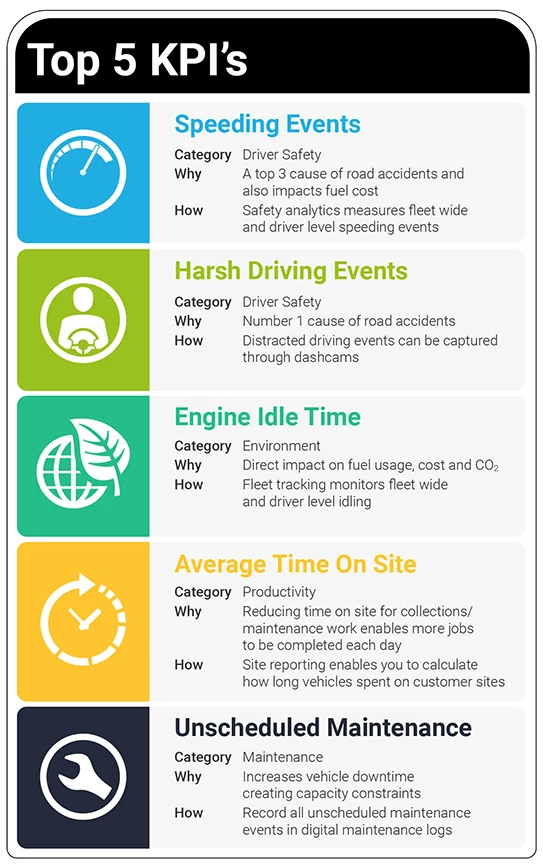Key Takeaways
Proper planning is vital to the success of any business or operation. Whether you’re updating your existing fleet management plan or writing one for the first time, it’s important to take a look at your entire operation and make sure that you are focusing your plan on the biggest opportunities for improvement. Your corporate fleet management plan is a blueprint of your fleet’s day-to-day operations, maintenance and usage, and it should position the business to focus on improving critical key performance indicators. In this article, we will explore, what a fleet management plan is, how to build a fleet management plan and how fleet tracking software can help you put one in place.
What is a fleet managment plan?
Your corporate fleet management plan is a document that outlines every aspect of managing a fleet, from usage requirements, maintenance intervals, location, expenses, and should centre around critical goals and KPI’s tied to the business’s overall success. Fleet management plans should be based on current performance across areas including usage, safety, maintenance and compliance, and outline key areas of focus. These should include current performance, improvement plans and how success will be measured. The use of fleet management software is a great way to help you understand current performance and track improvement over time.
Your plan should highlight specific calls to action for drivers, managers, and executives.
It’s also important to understand the fleet management plan is always evolving. Nothing is set in stone and it’s crucial to review your plan at least twice a year.
Here are a few goals and KPIs to consider:
- Vehicle utilisation
- Fuel consumption
- Maintenance and repairs
- Safety
- Compliance
- Driver behaviour

How to build a fleet management plan
Assembling a fleet management plan takes careful consideration. Start by asking yourself and your organisation several questions, including:
- What are your fleet management goals?
- What data is most important to capture and why?
- How will your team interact with this data?
- What technology, either already in place or future use, will be required?
- What does success look like?
Here are a few things to consider as you start to draft your fleet management plan:
Setting the proper goals and KPIs
Goal setting is one of the more integral aspects of a corporate fleet management plan. Take a thorough look at the status of your fleet and identify the biggest opportunities for improvement and consider your limitations. For example is your fleet being under-utilised and is there an opportunity to right-size? Or is unexpected downtime impacting your bottom line? Every fleet is different and so are the key points of focus.
A robust fleet management system can play an integral role in identifying the biggest opportunities for improvement. By gathering accurate performance data covering safety, productivity, utilisation and maintenance, it can help you understand your performance benchmark against peers and identify your biggest improvement opportunities.
Fleet Usage and Optimisation
Your fleet is an expensive asset and ensuring that you are only acquiring vehicles that are necessary is an important factor in minimising operational costs. You should be looking at utilisation as part of your fleet management plan and leverage fleet tracking software to get an accurate picture of how often vehicles are used and identify unused capacity. You only want to be purchasing new vehicles if they are needed.
It is also important to measure unauthorised vehicle use and understand the cost of this to the business. There are often significant savings that can be made by reducing fuel use and maintenance costs by reducing the number of unauthorised distance being driven.
Fleet Maintenance
In terms of fleet maintenance, your corporate fleet management plan should make use of the various fleet tracking software features designed for exactly that. The latest fleet tracking software has the capability for you to track maintenance and the associated costs. This gives you a view on total cost of ownership that can be tracked as a KPI and help you identify vehicles that you should be looking to replace.
Fleet tracking software also enables you to build preventative maintenance schedules, get instant visibility on maintenance needs through digital inspection forms and receive engine diagnostic alerts. All of this is designed so you can reduce the need for unscheduled maintenance.
Compliance
There are multiple rules, regulations, laws and requirements around managing a fleet and keeping everyone safe. Compliance should be a centre point of your fleet management plan.
What steps will you take to ensure your fleet and drivers remain compliant under federal, state, and local laws? How will you manage a compliance-related issue? What steps are necessary to ensure such an issue never happens again?
Your fleet tracking solution can play a big role in ensuring compliance, with products designed to simplify hours of service management, fuel tax reporting and maintenance process. The latest tools also have the ability to report on violations, for deeper review and investigation.
Driver Safety and Training
Fleet tracking software will instantly identify situations where drivers may be displaying unsafe practices like speeding or harsh braking. You can use this data to prioritise training to help eliminate these behaviors and build a culture of safety within your organisation. The use of driver safety league tables and incentive programs are great ways to encourage the right behavior and can be automated from the more advanced fleet tracking systems.
Your driver safety policy should be focused on keeping your team safe on the road, but your business can also expect to see incident and collision rates reduce, which creates savings on repairs and reduces vehicle downtime. Both of which are key performance measures that you can track in a fleet management platform.

